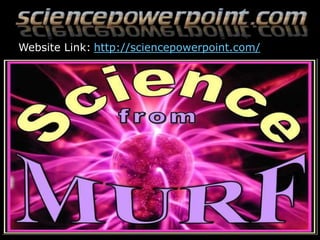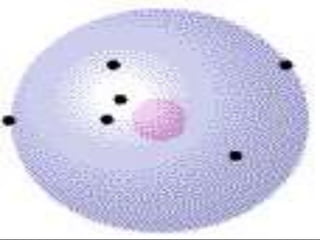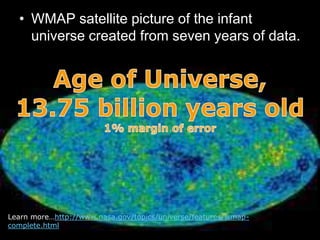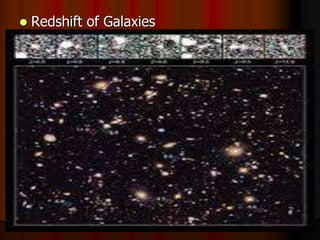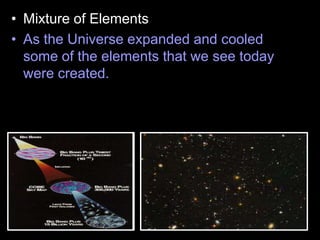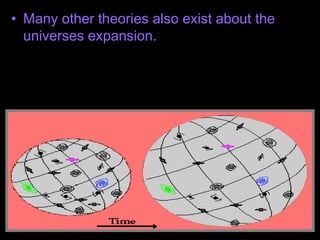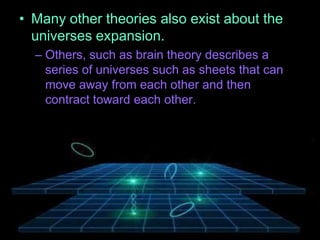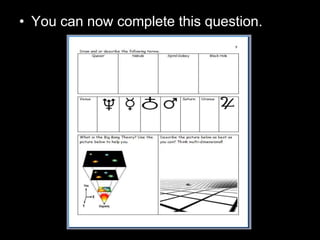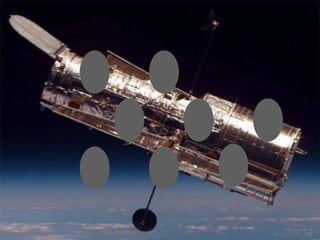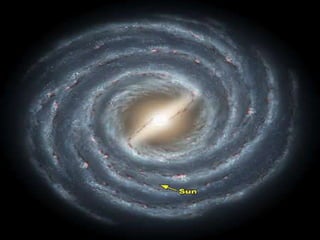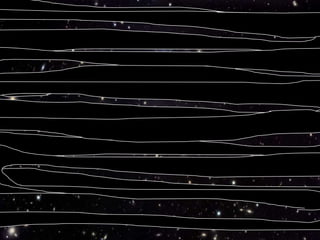Big Bang Theory Astronomy Lesson PowerPoint
- 1. • WMAP satellite picture of the infant universe created from seven years of data. Learn more…http://www.nasa.gov/topics/universe/features/wmap- complete.html
- 4. • RED SLIDE: These are notes that are very important and should be recorded in your science journal. Copyright © 2010 Ryan P. Murphy
- 5. -Nice neat notes that are legible and use indentations when appropriate. -Example of indent. -Skip a line between topics -Don’t skip pages -Make visuals clear and well drawn.
- 6. • RED SLIDE: These are notes that are very important and should be recorded in your science journal. • BLACK SLIDE: Pay attention, follow directions, complete projects as described and answer required questions neatly. Copyright © 2010 Ryan P. Murphy
- 8. • Everyone look at your hand.
- 9. • Everyone look at your hand.
- 10. • Everyone look at your hand.
- 11. • Everyone look at your hand.
- 12. Copyright © 2010 Ryan P. Murphy
- 13. The Big Bang Theory: The cosmic explosion that is hypothesized to have marked the origin of the Universe. Copyright © 2010 Ryan P. Murphy
- 14. The Big Bang Theory: The cosmic explosion that is hypothesized to have marked the origin of the Universe. Copyright © 2010 Ryan P. Murphy
- 20. Copyright © 2010 Ryan P. Murphy It has to do with the uncertainty principle.
- 21. Copyright © 2010 Ryan P. Murphy It has to do with the uncertainty principle.
- 22. Copyright © 2010 Ryan P. Murphy It has to do with the uncertainty principle.
- 23. Copyright © 2010 Ryan P. Murphy It has to do with the uncertainty principle.
- 24. Copyright © 2010 Ryan P. Murphy It has to do with the uncertainty principle.
- 25. Copyright © 2010 Ryan P. Murphy It has to do with the uncertainty principle.
- 26. Copyright © 2010 Ryan P. Murphy It has to do with the uncertainty principle.
- 27. Copyright © 2010 Ryan P. Murphy It has to do with the uncertainty principle.
- 28. Copyright © 2010 Ryan P. Murphy It has to do with the uncertainty principle.
- 29. Copyright © 2010 Ryan P. Murphy It has to do with the uncertainty principle.
- 56. • WMAP satellite picture of the infant universe created from seven years of data.
- 57. • WMAP satellite picture of the infant universe created from seven years of data. Learn more…http://www.nasa.gov/topics/universe/features/wmap- complete.html
- 58. Evidence for the Big Bang Theory - - - -
- 59. Redshift of Galaxies The redshift of distant galaxies means that the Universe is probably expanding. If we went back far enough in time, everything must have been squashed together into a very small space.
- 60. Redshift of Galaxies The redshift of distant galaxies means that the Universe is probably expanding. If we went back far enough in time, everything must have been squashed together into a very small space.
- 61. • Redshift of Galaxies • The redshift of distant galaxies means that the Universe is probably expanding.
- 62. • Redshift of Galaxies • The redshift of distant galaxies means that the Universe is probably expanding. • If we went back far enough in time, everything must have been squashed together into a very small space.
- 63. • Activity! The expansion of the Universe with a balloon. – Everyone blow up a balloon (Do not pop one!) – With sharpie maker create galaxies all around it. – Deflate balloon and then blow up. (repeat). Copyright © 2010 Ryan P. Murphy
- 64. Microwave Background Very early, the whole Universe was extremely hot. As it expanded, the heat left behind a "glow". The Big Bang theory predicts that this glow should exist, but that it should be visible as microwaves (EM Waves) The Cosmic Microwave Background has been accurately measured by orbiting detectors.
- 65. • Microwave Background – Early on the whole Universe was extremely hot. As it expanded, the heat left behind a "glow". The Big Bang theory predicts that this glow should exist, but that it should be visible as microwaves (EM Waves)
- 66. • Microwave Background – Early on the whole Universe was extremely hot. As it expanded, the heat left behind a "glow". The Big Bang theory predicts that this glow should exist, but that it should be visible as microwaves (EM Waves) – The Cosmic Microwave Background has been accurately measured by orbiting detectors.
- 67. Mixture of Elements As the Universe expanded and cooled some of the elements that we see today were created. The Big Bang theory accurately predicts how much of each element should have been made in the early universe. The numbers add up.
- 68. • Mixture of Elements • As the Universe expanded and cooled some of the elements that we see today were created.
- 69. • Mixture of Elements • As the Universe expanded and cooled some of the elements that we see today were created. – The Big Bang theory accurately predicts how much of each element should have been made in the early universe. The numbers add up.
- 70. • Mixture of Elements • As the Universe expanded and cooled some of the elements that we see today were created. – The Big Bang theory accurately predicts how much of each element should have been made in the early universe. The numbers add up. Our Sun is a new star, it formed from the gases of an exploded star
- 71. Looking back in time The alternative to the Big Bang theory of the Universe is called the Steady State theory. In this theory the Universe does not change very much with time. Light takes a long time to travel across the Universe, when we look at very distant galaxies, we look back in time. Galaxies a long time ago are different from those today, showing that the Universe has changed. This fits better with the Big Bang theory than the Steady State theory.
- 72. • Looking back in time • The alternative to the Big Bang theory of the Universe is called the Steady State theory. In this theory the Universe does not change very much with time. – Light takes a long time to travel across the Universe, when we look at very distant galaxies, we look back in time. • Galaxies a long time ago are different from those today, showing that the Universe has changed. • This fits better with the Big Bang theory than the Steady State theory.
- 73. • Looking back in time • The alternative to the Big Bang theory of the Universe is called the Steady State theory. In this theory the Universe does not change very much with time. – Light takes a long time to travel across the Universe, when we look at very distant galaxies, we look back in time. • Galaxies a long time ago are different from those today, showing that the Universe has changed. • This fits better with the Big Bang theory than the Steady State theory.
- 74. • Looking back in time • The alternative to the Big Bang theory of the Universe is called the Steady State theory. In this theory the Universe does not change very much with time. – Light takes a long time to travel across the Universe, when we look at very distant galaxies, we look back in time. • Galaxies a long time ago are different from those today, showing that the Universe has changed.
- 75. • Looking back in time • The alternative to the Big Bang theory of the Universe is called the Steady State theory. In this theory the Universe does not change very much with time. – Light takes a long time to travel across the Universe, when we look at very distant galaxies, we look back in time. • Galaxies a long time ago are different from those today, showing that the Universe has changed. – This fits better with the Big Bang theory than the Steady State theory.
- 77. • Which comment below is completely bogus? – A.) As the Universe expanded and cooled some of the elements that we see today were created. – B.) The cosmic forces in the universe have been shrinking in size and scale as described by decreasing radiation. – C.) The redshift of distant galaxies means that the Universe is probably expanding. – D.) The Cosmic Microwave Background has been accurately measured by orbiting detectors.
- 78. • Which comment below is completely bogus? And the answer is… – A.) As the Universe expanded and cooled some of the elements that we see today were created. – B.) The cosmic forces in the universe have been shrinking in size and scale as described by decreasing radiation. – C.) The redshift of distant galaxies means that the Universe is probably expanding. – D.) The Cosmic Microwave Background has been accurately measured by orbiting detectors.
- 79. • Which comment below is completely bogus? And the answer is… – A.) As the Universe expanded and cooled some of the elements that we see today were created. – B.) The cosmic forces in the universe have been shrinking in size and scale as described by decreasing radiation. – C.) The redshift of distant galaxies means that the Universe is probably expanding. – D.) The Cosmic Microwave Background has been accurately measured by orbiting detectors.
- 80. • Which comment below is completely bogus? And the answer is… – A.) As the Universe expanded and cooled some of the elements that we see today were created. – B.) Remember, the universe is expanding. – C.) The redshift of distant galaxies means that the Universe is probably expanding. – D.) The Cosmic Microwave Background has been accurately measured by orbiting detectors.
- 81. • Video Link! The Big Bang – http://www.youtube.com/watch?v=jx_OBw189t8
- 82. • Many other theories also exist about the universes expansion. – Some explain a universe that expands like an inflated balloon and then contracts a bit and then expands, never reaching a big bang or big crunch.
- 83. • Many other theories also exist about the universes expansion. – Some explain a universe that expands like an inflated balloon and then contracts a bit and then expands, never reaching a big bang or big crunch.
- 84. • Many other theories also exist about the universes expansion. – Others, such as brain theory describes a series of universes such as sheets that can move away from each other and then contract toward each other.
- 85. • Many other theories also exist about the universes expansion. – Others, such as brain theory describes a series of universes such as sheets that can move away from each other and then contract toward each other.
- 86. • Many other theories also exist about the universes expansion. – Others, such as brain theory describes a series of universes such as sheets that can move away from each other and then contract toward each other. • When they meet, it’s a Big Bang event.
- 91. • The Universe will eventually run out of energy. Copyright © 2010 Ryan P. Murphy
- 92. • The universe will eventually run out of energy. Everything will become lifeless and frozen at some point. Copyright © 2010 Ryan P. Murphy
- 93. • The universe will eventually run out of energy. Everything will become lifeless and frozen at some point. The last stars will fade… Copyright © 2010 Ryan P. Murphy
- 94. • The universe will eventually run out of energy. Everything will become lifeless and frozen at some point. The last stars will fade… Copyright © 2010 Ryan P. Murphy
- 95. • The universe will eventually run out of energy. Everything will become lifeless and frozen at some point. The last stars will fade… Copyright © 2010 Ryan P. Murphy
- 96. • The universe will eventually run out of energy. Everything will become lifeless and frozen at some point. The last stars will fade… Copyright © 2010 Ryan P. Murphy
- 97. • The universe will eventually run out of energy. Everything will become lifeless and frozen at some point. The last stars will fade… Copyright © 2010 Ryan P. Murphy
- 104. THE BIG CHRUNCH?
- 105. THE BIG CHRUNCH?
- 106. THE BIG CHRUNCH?
- 107. THE BIG CHRUNCH?
- 108. THE BIG CHRUNCH?
- 119. • Another theory is the big rip. – The matter of the universe, from stars and galaxies to atoms and subatomic particles, is progressively torn apart by the expansion of the universe at a certain time in the future. • Occurs from the dark energy in the universe. Learn More: http://www.youtube.com/watch?v=JaImVFRpOR8
- 120. • Video Link! Death of the Universe? (Theory) – http://www.youtube.com/watch?v=jmcf7T92H7M &feature=relmfu
- 121. • You can now complete this question.
- 124. • Extension of the prior two videos. (Optional) – Birth and Death of the Universe. – Part I (Old): http://www.youtube.com/watch?v=PV0ACIykxQI – Part II: (Old) – http://www.youtube.com/watch?v=phV- Zpy1BeM&feature=relmfu – Part III: (New) – http://www.youtube.com/watch?v=fK375XB3v08&feature= relmfu – Part IV: – http://www.youtube.com/watch?v=gr8zLAxPs- A&feature=related – Part V: http://www.youtube.com/watch?v=_l0yxRRCrfk&feature=r elmfu
- 125. • Try and guess the picture beneath the boxes. – Raise your hand when you know. You only get one guess. Copyright © 2010 Ryan P. Murphy
- 136. • Try and guess the picture beneath the boxes. – Raise your hand when you know. You only get one guess. Copyright © 2010 Ryan P. Murphy
- 151. • Try and guess the picture beneath the boxes. – Raise your hand when you know. You only get one guess. Copyright © 2010 Ryan P. Murphy
- 161. Artistic rendition
- 162. Artistic rendition
- 163. Artistic rendition
- 164. • Try and guess the picture beneath the boxes. – Raise your hand when you know. You only get one guess. Copyright © 2010 Ryan P. Murphy
- 184. • Video - Final Message: Carl Sagan • “The Pale Blue Dot” – http://www.youtube.com/watch?v=8Lm6pEhykhs
- 185. • You can now complete the crossword puzzle.
- 187. • Space Expo arriving shortly.
- 188. • “AYE” Advance Your Exploration ELA and Literacy Opportunity Worksheet – Visit some of the many provided links or.. – Articles can be found at (w/ membership to NABT and NSTA) • http://www.nabt.org/websites/institution/index.php?p= 1 • http://learningcenter.nsta.org/browse_journals.aspx?j ournal=tst Please visit at least one of the “learn more” educational links provided in this unit and complete this worksheet
- 189. • “AYE” Advance Your Exploration ELA and Literacy Opportunity Worksheet – Visit some of the many provided links or.. – Articles can be found at (w/ membership to and NSTA) • http://www.scientificamerican.com/space • http://learningcenter.nsta.org/browse_journals.aspx?jo urnal=tst
- 193. • More Units Available at… Earth Science: The Soil Science and Glaciers Unit, The Geology Topics Unit, The Astronomy Topics Unit, The Weather and Climate Unit, and The River Unit, The Water Molecule Unit. Physical Science: The Laws of Motion and Machines Unit, The Atoms and Periodic Table Unit, The Energy and the Environment Unit, and The Introduction to Science / Metric Unit. Life Science: The Diseases and Cells Unit, The DNA and Genetics Unit, The Life Topics Unit, The Plant Unit, The Taxonomy and Classification Unit, Ecology: Feeding Levels Unit, Ecology: Interactions Unit, Ecology: Abiotic Factors, The Evolution and Natural Selection Unit and The Human Body and Health Topics Unit. Copyright © 2010 Ryan P. Murphy
- 194. • This Solar System Basics and the Sun lesson is just one small part of my Astronomy Topics Unit. This unit includes • A five part 2,800 Slide PowerPoint Presentation / unit roadmap full of activities, review questions, games, video links, materials list, and much more. • A 13 bundled homework package, modified version, 7 pages of unit notes, 4 PowerPoint Review Games of 100+ slides each, videos, rubrics, and much more that all chronologically follow the unit slideshow. • This is a fantastic unit for any Earth Science Class. • http://sciencepowerpoint.com/Astronomy_Unit.html
- 196. Areas of Focus in the Astronomy Topics Unit: The Solar System and the Sun, Order of the Planets, Our Sun, Life Cycle of a Star, Size of Stars, Solar Eclipse, Lunar Eclipse, The Inner Planets, Mercury, Venus, Earth, Moon, Craters, Tides, Phases of the Moon, Mars and Moons, Rocketry, Asteroid Belt, NEO’s, The Torino Scale, The Outer Planets and Gas Giants, Jupiter / Moons, Saturn / Moons, Uranus / Moons, Neptune / Moons, Pluto's Demotion, The Kuiper Belt, Oort Cloud, Comets / Other, Beyond the Solar System, Types of Galaxies, Black holes, Extrasolar Planets, The Big Bang, Dark Matter, Dark Energy, The Special Theory of Relativity, Hubble Space Telescope, Constellations, Age of the Earth, Time, Earth events in a 12 hour day, Principle of Superposition, Geologic Timescale, Extinction Events, Dinosaurs, and much more. Full Unit found at... http://sciencepowerpoint.com/Astronomy_Unit.html
- 197. • This was a very brief 5 mb tour. Please visit the links below to learn more about each of the units in this curriculum package. – These units take me about four years to complete with my students in grades 5-10. Earth Science Units Extended Tour Link and Curriculum Guide Geology Topics Unit http://sciencepowerpoint.com/Geology_Unit.html Astronomy Topics Unit http://sciencepowerpoint.com/Astronomy_Unit.html Weather and Climate Unit http://sciencepowerpoint.com/Weather_Climate_Unit.html Soil Science, Weathering, More http://sciencepowerpoint.com/Soil_and_Glaciers_Unit.html Water Unit http://sciencepowerpoint.com/Water_Molecule_Unit.html Rivers Unit http://sciencepowerpoint.com/River_and_Water_Quality_Unit.html = Easier = More Difficult = Most Difficult 5th – 7th grade 6th – 8th grade 8th – 10th grade
- 198. Physical Science Units Extended Tour Link and Curriculum Guide Science Skills Unit http://sciencepowerpoint.com/Science_Introduction_Lab_Safety_Metric_Methods. html Motion and Machines Unit http://sciencepowerpoint.com/Newtons_Laws_Motion_Machines_Unit.html Matter, Energy, Envs. Unit http://sciencepowerpoint.com/Energy_Topics_Unit.html Atoms and Periodic Table Unit http://sciencepowerpoint.com/Atoms_Periodic_Table_of_Elements_Unit.html Life Science Units Extended Tour Link and Curriculum Guide Human Body / Health Topics http://sciencepowerpoint.com/Human_Body_Systems_and_Health_Topics_Unit.html DNA and Genetics Unit http://sciencepowerpoint.com/DNA_Genetics_Unit.html Cell Biology Unit http://sciencepowerpoint.com/Cellular_Biology_Unit.html Infectious Diseases Unit http://sciencepowerpoint.com/Infectious_Diseases_Unit.html Taxonomy and Classification Unit http://sciencepowerpoint.com/Taxonomy_Classification_Unit.html Evolution / Natural Selection Unit http://sciencepowerpoint.com/Evolution_Natural_Selection_Unit.html Botany Topics Unit http://sciencepowerpoint.com/Plant_Botany_Unit.html Ecology Feeding Levels Unit http://sciencepowerpoint.com/Ecology_Feeding_Levels_Unit.htm Ecology Interactions Unit http://sciencepowerpoint.com/Ecology_Interactions_Unit.html Ecology Abiotic Factors Unit http://sciencepowerpoint.com/Ecology_Abiotic_Factors_Unit.html
- 199. • More Units Available at… Earth Science: The Soil Science and Glaciers Unit, The Geology Topics Unit, The Astronomy Topics Unit, The Weather and Climate Unit, and The Rivers and Water Quality Unit, The Water Molecule Unit. Physical Science: The Laws of Motion and Machines Unit, The Atoms and Periodic Table Unit, The Energy and the Environment Unit, and Science Skills Unit. Life Science: The Diseases and Cells Unit, The DNA and Genetics Unit, The Life Topics Unit, The Plant Unit, The Taxonomy and Classification Unit, Ecology: Feeding Levels Unit, Ecology: Interactions Unit, Ecology: Abiotic Factors, The Evolution and Natural Selection Unit and The Human Body Systems and Health Topics Unit Copyright © 2010 Ryan P. Murphy
- 200. • The entire four year curriculum can be found at... http://sciencepowerpoint.com/ Please feel free to contact me with any questions you may have. Thank you for your interest in this curriculum. Sincerely, Ryan Murphy M.Ed www.sciencepowerpoint@gmail.com


